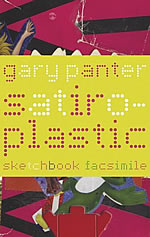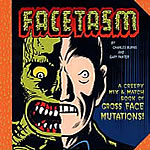Gary Panter:
Panter-Monium
Who would you narrow down to put into a massive exhibition of just 15 US comics creators who reinvented the medium in the 20th century?
Here’s the shortlist whose original artworks are showing in a stunning museum-quality survey that opened in the winter of 2005 in Los Angeles and is touring America until the spring of 2007: Winsor McCay, George Herriman, Lyonel Feininger, EC Segar, Frank King, Chester Gould, Milton Caniff, Charles Schulz, Will Eisner, Jack Kirby, Harvey Kurtzman, R Crumb, Art Spiegelman, Chris Ware and Gary Panter.
That’s some line-up, and the accompanying catalogue is stunning, but perhaps the last name is not so familiar. The Simpson’s Matt Groening is one of his many admirers: "Some artists could build entire careers exploring what Gary Panter offers on a single page."
In fact, Panter’s gallery acclaim has brought the Texan-raised designer, illustrator, painter and fireball full-circle back to Los Angeles. It was here in the 1970s that his crackling, raw-edged scrawling first stunned the readers of hardcore-punk newspaper Slash.
While he may have been hailed as the ‘King Of Punk Art’, Panter is unassuming about this belated artworld recognition: "Stylistic innovation is the only way I can be included in a show like this. Many many people, I am confident, will debate and decry my inclusion. On the other hand, I’m not going to fight good vibes. I’d be a dope if I did."
This exhibition suggests that the tired Anglo-American chasm between highbrow and lowbrow may be narrowing at last. "I wish they could get that hairy brow out of the picture. The low and high arts are always stealing and being enriched by each other. Important species messages can flow through high or low sources and the message doesn’t care about the conduit."
Panter’s earliest "important interspecies messages" in the pages of Slash unleashed Jimbo, his prototypical punk: innocent, beefy, spikey-haired, freckled-faced and surviving in a post-nuclear no-future.
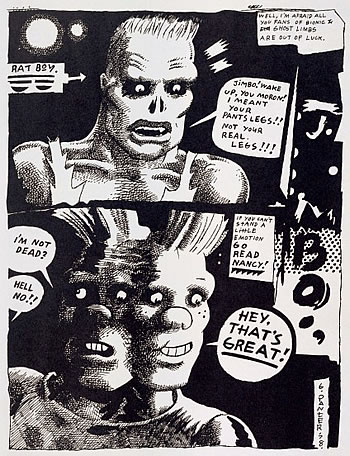
Panter’s nervy, muscular mark-making almost carved out of paper, was the defining graphic counterpart of US punk rock. It marked a rejection of traditional and empty polish, as radical a break with the sex-and-dope underground comix as punk music was with hippie rock groups. Shifting from street-level Slash to New York no-wave graphix mag Raw, Jimbo became Panter’s outraged hero-vehicle who possesses him to this day. "I guess Jimbo has become a sort of alter ego, because I wouldn’t want him to do anything that I wouldn’t do."
Panter’s drawing was dubbed the "ratty line" and has never quite lost its folksy naive shakiness, prompting Village Voice to declare it, "the only punk art there is." Not that Panter’s work is some period piece. Call it appropriating, sampling or theft, his approach has never stopped morphing, feeding off a mulch of the trashy treasures of his ‘50s childhood and mixing a myriad discoveries, from medieval religious painting to Japanese prints, to personalise from them something totally unexpected.
As Panter declared in 1980 in his Rozz Tox manifesto: "Inspiration has always been born of recombination."
John Carlin, co-curator of the LA museum’s show, rates Panter for bring, "not only a new style of psychology… a new sense of what it was like to live a culture full of amusing signs that make less and less sense the more you stare at them."
Gary Panter’s "recombination" approach rippled out across America and was a wellspring for a global avant garde stretching from Marseille’s Le Dernier Cri to Tokyo’s Terry Flamingo back to Providence, Rhode Island’s Fort Thunder experimenter and the inspired Ron Regé Jr.
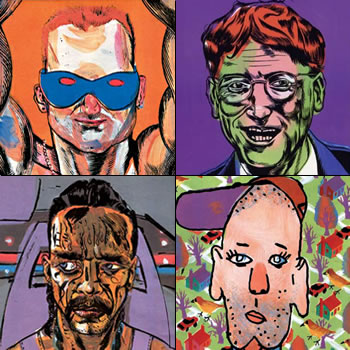
His undeniable impact on a generation of graphic designers won Panter the 2000 Chrysler Design Award in recognition of his comics and his output across the board. In the early 1980s, he made the almost inevitable leap from drawing in Slash to being sought out to design record covers. One high point was drawing the sleeves for Frank Zappa’s Orchestral Favourites, Studio Tan and Sleep Dirt. "I heard that Frank liked my covers OK. That was a relief." Panter never met Zappa but became good friends with other musicians who also hired him including The Residents and The Red Hot Chili Peppers.
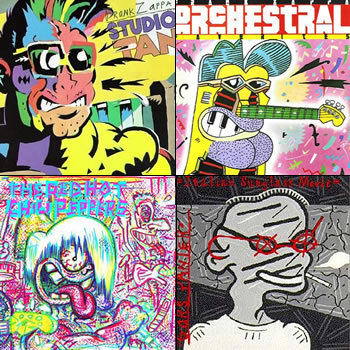
His drawings for Slash, Raw, Wet and other magazines also lead to a phone call from Paul Reubens about his PeeWee Herman act, a wacky nine-year-old boy living in a grown-up’s body, tight-fitting preppy suit and a freaky childhood dreamland. Out of this developed the 1986 children’s television series Pee Wee’s Playhouse.
While it harked back to the corny charms of 1950s kiddie shows, nothing quite as truly weird and infectious had ever been seen on American Saturday morning TV.
Panter brought in his cronies from the cartooning underground on the show’s zany decors and anarchic characters, like Conky the stuttering robot who supplies "today’s magic word", bratty puppet Randy, the beatnik Puppet Land Band and Jambi the wish-granting genie.
"Pals Wayne White and Ric Heitzman were my main collaborators on the show. Cartoonist/composer Jay Cotton did the original music for Pee Wee." Adults as well as kids became hooked and there was a spree of Pee Wee toys and merchandise, involving Panter and others.
In grey Britain, neither the BBC nor Channel 4 knew quite what to make of the series and it was never aired, a real pop cultural loss.
In America, Pee Wee proved revolutionary and justly earned Panter three Emmy awards for his production panache, bringing hordes of people with grandiose schemes o his door. Panter had to be realistic. "It takes a lot to get a big project in the air. There are many false starts and many plans that did not pan out." Still, some did.

New York’s Philippe Stark-designed Paramount Hotel, for example, unleashed Panter on their children’s playroom with eye-popping results, now dismantled after years of playtime. Although proposals for animated series, such as Kaktus Valley or Pee Wee himself, never quite made it, his Pink Donkey And The Fly took off as a cult hit on The Cartoon Network’s website.
Through it all, Jimbo’s symbiotic life keeps running and resurfacing in Panter’s work. In 1985, Matt Groaning asked him to put out a regular Jimbo book for his new Zongo Comics line. Groening raved about Jimbo as, "a wild combo-platter of brilliant drawing and stuff you didn’t know could be done with mere pen and ink."
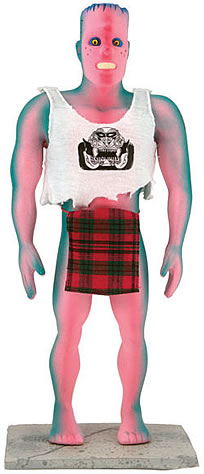
Jimbo Vinyl Figure
Available from Dark
Horse Comics
In 1997, Panter felt Jimbo calling again and led him to conceive two extraordinary graphic epics, Jimbo In Purgatory and Jimbo’s Inferno. Both are huge in their hardback format and their ambition to reinterpret Dante’s infernal ideas for the 21st century. Panter casts Jimbo in the role of Dante, while "parole robot" Valise plays Virgil, as they traverse a modern hellscape of a vast infotainment testing centre, populated by Alice Cooper, Boy George, John & Yoko, a zombie Elvis, the robots from Westworld and Metropolis, who usher them into a swirling descent and a crescendo of coiling snakes, psychedelic auras, symbolic mandalas.
Purgatory‘s 31 pages form an intense Joycean feast of visual and verbal references, their words quoted from a reading list footnoted on each page, "mostly classical satires like Lucian and Juvenal. American education doesn’t stress the great satires, so I recommend them." These latest Jimbo compositions read like mystical diagrams or mesmerising icons of some archaic religion, their nine or twelve panel grids ready for you to decipher one at a time and to contemplate as single overarching images.
These two tomes mark a return for Panter to his recurring concerns about the oppression and entrapment of the individual, echoes of Bush’s Amerika. As he sees it, "We are flying right into the web. Like flying sheep." Still, daily music-making and above all drawing offer him an outlet and meaning. "Drawing is vital to me, and capturing ideas for later use, freezing the flowing visions." Letting his mind pour onto paper, he keeps copious sketchbooks, one of which, Satiro-Plastic, was published as an exact, unedited facsimile.
Beavering away in his Brooklyn studio-nest to the sound of up to six beatboxes at once ("Sometimes four Pink Floyd records are better than one.") Gary is still that wide-eyed Southern nature boy, untroubled by heaven or hell, marveling at the worlds he can see and imagine. "In my dirt-simple way I’d think that any giant, helpful intellect in the universe would simply want to have a look, and want us monkeys to enjoy it and get along and ponder it too. Hell is too hellish an idea." "Do ants and prairie dogs have legacies? I am an ant or a prairie dog."
Panter has not stopped re-imagining what comics can do in the 21st century. Visit his web-site to see why he is one of the 20th century’s American Masters.
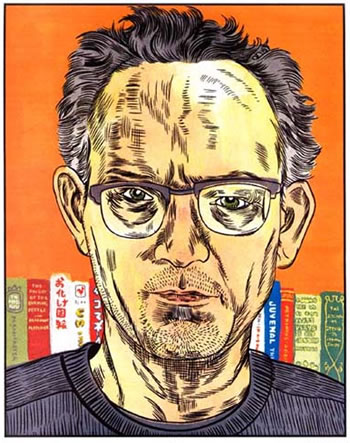
The original version of this article appeared in 2006 in the pages of Comics International, the UK’s leading magazine about comics.















